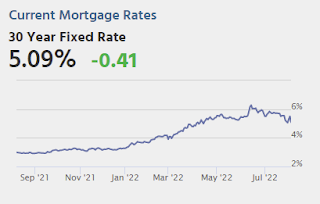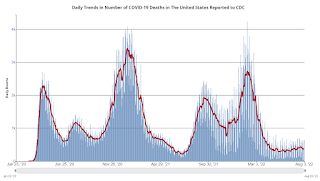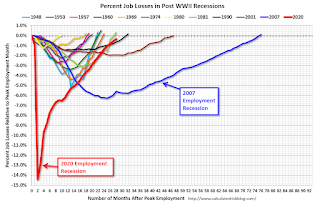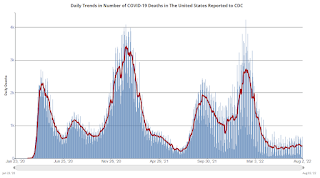by Calculated Risk on 8/04/2022 08:48:00 PM
Thursday, August 04, 2022
Friday: Employment Report

Goldman July Payrolls Preview
Friday:
• At 8:30 AM ET, Employment Report for July. The consensus is for 250,000 jobs added, and for the unemployment rate to be unchanged at 3.6%.
On COVID (focus on hospitalizations and deaths):
| COVID Metrics | ||||
|---|---|---|---|---|
| Now | Week Ago | Goal | ||
| New Cases per Day2 | 117,350 | 126,536 | ≤5,0001 | |
| Hospitalized2 | 37,220 | 37,451 | ≤3,0001 | |
| Deaths per Day2 | 377 | 397 | ≤501 | |
| 1my goals to stop daily posts, 27-day average for Cases, Currently Hospitalized, and Deaths 🚩 Increasing 7-day average week-over-week for Cases, Hospitalized, and Deaths ✅ Goal met. | ||||
 Click on graph for larger image.
Click on graph for larger image.This graph shows the daily (columns) and 7-day average (line) of deaths reported.
Goldman July Payrolls Preview
by Calculated Risk on 8/04/2022 04:44:00 PM
A few brief excerpts from a note by Goldman Sachs economist Spencer Hill:
We estimate nonfarm payrolls rose by 225k in July (mom sa) ... The July seasonal factors have become significantly more restrictive—even more so than in June—and the seasonal adjustment algorithm may be overfitting to the reopening-related job strength in the summers of 2020 and 2021. ... We estimate that the unemployment rate was unchanged at 3.6% in July ...CR Note: The consensus is for 250 thousand jobs added, and for the unemployment rate to be unchanged at 3.6%.
emphasis added
Hotels: Occupancy Rate Down 3.8% Compared to Same Week in 2019
by Calculated Risk on 8/04/2022 03:37:00 PM
U.S. hotel performance dipped slightly from the previous week, which was the traditional summer travel peak, according to STR‘s latest data through July 30.The following graph shows the seasonal pattern for the hotel occupancy rate using the four-week average.
July 24-30, 2022 (percentage change from comparable week in 2019*):
• Occupancy: 71.9% (-3.8%)
• Average daily rate (ADR): $158.32 (+18.3%)
• Revenue per available room (RevPAR): $113.90 (+13.9%)
*Due to the pandemic impact, STR is measuring recovery against comparable time periods from 2019.
emphasis added
 Click on graph for larger image.
Click on graph for larger image.The red line is for 2022, black is 2020, blue is the median, and dashed light blue is for 2021. Dashed purple is 2019 (STR is comparing to a strong year for hotels).
Denver Real Estate in July: Sales Off 31.6% YoY, Inventory Up 81.5%
by Calculated Risk on 8/04/2022 01:13:00 PM
Today, in the Calculated Risk Real Estate Newsletter: Denver Real Estate in July: Sales Off 31.6% YoY, Inventory Up 81.5%
A brief excerpt:
Every month I track about 35 local housing markets in the US, and I usually post several markets at a time. But this is worth noting. Sales in Denver were off almost 32% year-over-year in July, compared to down 23.6% in June. This early reporting market suggests existing home sales will be even weaker in July than in June.There is much more in the article. You can subscribe at https://calculatedrisk.substack.com/
...
From the DMAR: DMAR Real Estate Market Trends ReportThe data confirms that the Denver Metro area is no longer in a shifting market. Instead, it has shifted, and the real estate market is more balanced. …DMAR reports total residential active inventory (detached and attached) was 7,361 at the end of July, up 21.5% from 6,057 at the end of June, and up 81.5% year-over-year from 4,056 in July 2021.
Every indicator points to the market shifting closer to a buyer’s market ....
July Employment Preview
by Calculated Risk on 8/04/2022 11:01:00 AM
On Friday at 8:30 AM ET, the BLS will release the employment report for July. The consensus is for 250,000 jobs added, and for the unemployment rate to be unchanged at 3.6%.
 Click on graph for larger image.
Click on graph for larger image.• First, currently there are still about 500 thousand fewer jobs than in February 2020 (the month before the pandemic).
This graph shows the job losses from the start of the employment recession, in percentage terms.
The current employment recession was by far the worst recession since WWII in percentage terms. However, the current employment recession, 28 months after the onset, has recovered quicker than the previous two recessions.
• ADP Report: The ADP employment report has been "paused" and is being retooled.
• ISM Surveys: Note that the ISM services are diffusion indexes based on the number of firms hiring (not the number of hires). The ISM® manufacturing employment index decreased in July to 49.9%, up from 47.3% last month. This would suggest about 20,000 jobs lost in manufacturing.
The ISM® services employment index increased in July to 49.1%, up from 47.4% last month. This would suggest service employment was increased about 50,000 in July.
Combined, the ISM surveys suggest only 30,000 jobs added in July.
• Unemployment Claims: The weekly claims report showed an increase in the number of initial unemployment claims during the reference week (includes the 12th of the month) from 233,000 in June to 261,000 in July. This would usually suggest a few more layoffs in June than in May. In general, weekly claims were above expectations in July.
Trade Deficit decreased to $79.6 Billion in June
by Calculated Risk on 8/04/2022 08:49:00 AM
From the Department of Commerce reported:
The U.S. Census Bureau and the U.S. Bureau of Economic Analysis announced today that the goods and services deficit was $79.6 billion in June, down $5.3 billion from $84.9 billion in May, revised.
June exports were $260.8 billion, $4.3 billion more than May exports. June imports were $340.4 billion, $1.0 billion less than May imports.
emphasis added
 Click on graph for larger image.
Click on graph for larger image.Exports increased and imports decreased in June.
Exports are up 23% year-over-year; imports are up 20% year-over-year.
Both imports and exports decreased sharply due to COVID-19, and have now bounced back.
The second graph shows the U.S. trade deficit, with and without petroleum.
 The blue line is the total deficit, and the black line is the petroleum deficit, and the red line is the trade deficit ex-petroleum products.
The blue line is the total deficit, and the black line is the petroleum deficit, and the red line is the trade deficit ex-petroleum products.Note that net, imports and exports of petroleum products are close to zero.
The trade deficit with China increased to $36.9 billion in June, from $27.7 billion a year ago.
Weekly Initial Unemployment Claims increase to 260,000
by Calculated Risk on 8/04/2022 08:37:00 AM
The DOL reported:
In the week ending July 30, the advance figure for seasonally adjusted initial claims was 260,000, an increase of 6,000 from the previous week's revised level. The previous week's level was revised down by 2,000 from 256,000 to 254,000. The 4-week moving average was 254,750, an increase of 6,000 from the previous week's revised average. The previous week's average was revised down by 500 from 249,250 to 248,750.The following graph shows the 4-week moving average of weekly claims since 1971.
emphasis added
 Click on graph for larger image.
Click on graph for larger image.The dashed line on the graph is the current 4-week average. The four-week average of weekly unemployment claims increased to 254,750.
The previous week was revised down.
Weekly claims were lower than the consensus forecast.
Wednesday, August 03, 2022
Thursday: Trade Deficit, Unemployment Claims
by Calculated Risk on 8/03/2022 09:17:00 PM

• At 8:30 AM ET, Trade Balance report for June from the Census Bureau. The consensus is the trade deficit to be $80.1 billion. The U.S. trade deficit was at $85.5 Billion the previous month.
• Also at 8:30 AM, The initial weekly unemployment claims report will be released. The consensus is for 265 thousand up from 256 thousand last week.
On COVID (focus on hospitalizations and deaths):
| COVID Metrics | ||||
|---|---|---|---|---|
| Now | Week Ago | Goal | ||
| New Cases per Day2 | 119,034 | 126,812 | ≤5,0001 | |
| Hospitalized2 | 37,132 | 37,286 | ≤3,0001 | |
| Deaths per Day2 | 387 | 396 | ≤501 | |
| 1my goals to stop daily posts, 27-day average for Cases, Currently Hospitalized, and Deaths 🚩 Increasing 7-day average week-over-week for Cases, Hospitalized, and Deaths ✅ Goal met. | ||||
 Click on graph for larger image.
Click on graph for larger image.This graph shows the daily (columns) and 7-day average (line) of deaths reported.
Heavy Truck Sales Solid in July
by Calculated Risk on 8/03/2022 02:28:00 PM
This graph shows heavy truck sales since 1967 using data from the BEA. The dashed line is the July 2022 seasonally adjusted annual sales rate (SAAR).
Heavy truck sales really collapsed during the great recession, falling to a low of 180 thousand SAAR in May 2009. Then heavy truck sales increased to a new all-time high of 570 thousand SAAR in April 2019.
 Click on graph for larger image.
Click on graph for larger image.Note: "Heavy trucks - trucks more than 14,000 pounds gross vehicle weight."
Heavy truck sales declined sharply at the beginning of the pandemic, falling to a low of 308 thousand SAAR in May 2020.
How Much will the Fannie & Freddie Conforming Loan Limit Increase for 2023?
by Calculated Risk on 8/03/2022 11:54:00 AM
Today, in the Calculated Risk Real Estate Newsletter: How Much will the Fannie & Freddie Conforming Loan Limit Increase for 2023?
A brief excerpt:
With house prices up sharply again over the last year, an interesting question is: How much will the Fannie & Freddie conforming loan limits (CLL) increase for 2023? And how much will the FHA insured loan limits increase?There is much more in the article. You can subscribe at https://calculatedrisk.substack.com/
First, there are different loan limits for various geographical areas. There are also different loan limits depending on the number of units (from 1 to 4 units). For example, currently the CLL is $647,200 for one-unit properties in low-cost areas. For Los Angeles County, the CLL is $970,800 for one-unit properties (50% higher than the baseline CLL).
...
This graph shows the CLL since 1979. The CLL was unchanged from 2006 though 2016.
...
The adjustment is based on the House Price Index value in Q3 divided by Q3 in the prior year. The FHFA index is a repeat sales index, similar to Case-Shiller.
...
Currently we only have data for Q1 2022 for the quarterly index (up 17.5% from Q1 2021), and the Purchase-Only index was up 18.3% through May 2022.
...
We need the house price data through September 2022 to calculate the conforming loan limit for 2023. This quarterly data will be released in late November.
Based on the current year-over-year house price change, the CLL could be close to $760,000 in 2023. However, year-over-year (YoY) house price growth is clearly slowing, and it is possible the CLL will be in the low-to-mid $700 thousand range for 2023.


